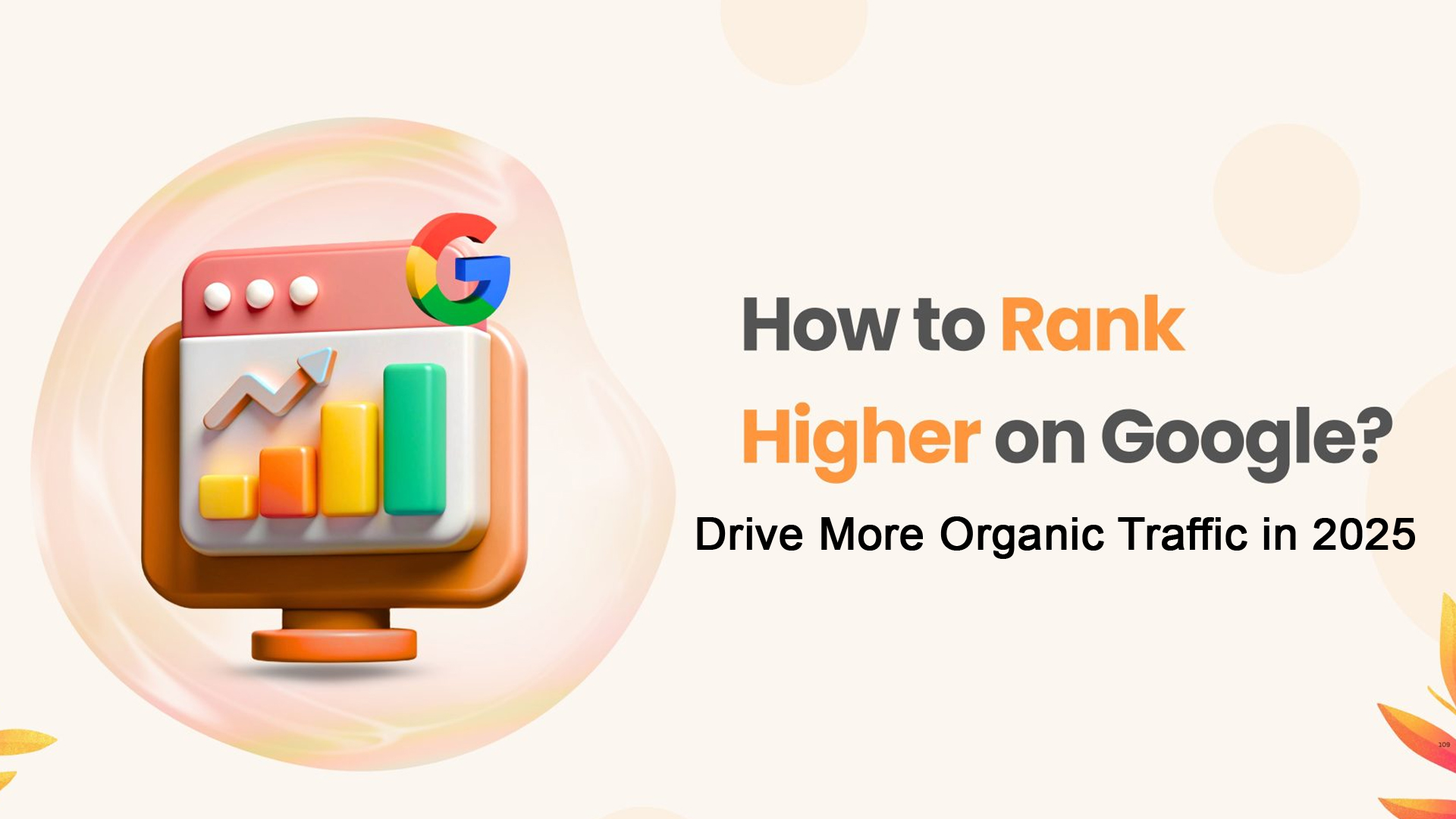Unlocking Visibility: How to Rank Higher and Drive More Organic Traffic in 2025
In the vast, dynamic expanse of the internet in 2025, every website, every blog, every online store is vying for attention. It’s a digital ecosystem where millions of voices compete to be heard. If your business, content, or product isn’t easily discoverable, it might as well not exist. This is the stark reality of modern online presence.
The holy grail of digital visibility is organic traffic – visitors who land on your website by clicking on a natural, unpaid search result. Unlike paid advertisements, organic traffic is a consistent, cost-effective, and highly valuable stream of users who are actively searching for what you offer. But how do you get your content to appear at the top of those search results, especially when Google processes trillions of queries annually? The answer lies in mastering Search Engine Optimization (SEO).
SEO is not a dark art; it’s a strategic, multi-faceted discipline focused on improving your website’s visibility in search engine results pages (SERPs). It’s about understanding how search engines work, what users are searching for, and delivering the best possible answer in the most accessible way. For businesses and content creators in India, where digital adoption is soaring and competition is fierce, a robust SEO strategy is no longer optional – it’s fundamental to survival and growth.
This comprehensive guide will break down the essential pillars of modern SEO in 2025, showing you how to rank higher, drive more organic traffic, and ultimately, supercharge your online success.
The Foundation: Understanding How Search Engines Work
Before you can optimize for search engines, you need to understand their core mission: to provide the most relevant and highest-quality results for any given user query. They achieve this through a complex, multi-stage process:
- Crawling: Search engine bots (spiders) discover new and updated web pages by following links from known sites, sitemaps, and other sources.
- Indexing: The information gathered by crawlers is processed and stored in a massive database, an index. This involves analyzing content, keywords, images, and other media.
- Ranking: When a user enters a query, the search engine’s algorithms sift through the index to find the most relevant and authoritative pages, then rank them based on hundreds of factors.
Key Ranking Factors in 2025: While the exact algorithm remains a secret, Google consistently emphasizes these core principles:
- Relevance: How well your content matches the user’s search intent and keywords.
- Authority: The trustworthiness and credibility of your website, primarily determined by the quality and quantity of backlinks from other reputable sites.
- User Experience (UX): How users interact with your site (speed, mobile-friendliness, ease of navigation, engagement metrics). This is increasingly intertwined with ranking.
- E-E-A-T (Experience, Expertise, Authoritativeness, Trustworthiness): Particularly crucial for “Your Money or Your Life” (YMYL) topics (health, finance, legal), Google wants to ensure that the content is created by knowledgeable and credible sources. Demonstrating actual experience with a topic has become the newest addition to E-A-T.
For most of the world, including India, Google dominates the search market, making it the primary target for your SEO efforts.
Pillar 1: On-Page SEO – Optimizing Your Content for Relevance
On-Page SEO refers to all the optimizations you can perform directly on your website’s pages to improve their search engine rankings.
1. Keyword Research: The Cornerstone of Discoverability
This is where it all begins. Effective keyword research isn’t just about finding popular words; it’s about understanding search intent – why a user is performing a specific search.
- Types of Search Intent:
- Informational: “How to tie a tie,” “history of Taj Mahal.”
- Navigational: “Amazon India login,” “Flipkart customer service.”
- Transactional: “buy iPhone 15 online,” “best washing machine deals.”
- Commercial Investigation: “best noise-cancelling headphones,” “SEO agency India review.”
- Tools:
- Google Keyword Planner: Free, provides search volume data and related keywords.
- SEMrush, Ahrefs, Ubersuggest: Comprehensive paid tools for in-depth keyword analysis, competitor research, and backlink tracking.
- Google Search Console: See what queries users are already using to find your site.
- Google Trends: Identify trending topics and search popularity over time.
- Strategy:
- Focus on Long-Tail Keywords: These are longer, more specific phrases (e.g., “best budget smartphone under ₹15000 in India”). They have lower search volume but higher conversion rates due to clear user intent.
- Identify Semantic Keywords: Words and phrases related to your primary keyword that help search engines understand the broader context of your content.
- Local SEO (Indian Context): Don’t forget local keywords if you serve a specific geographic area (e.g., “best cafe in Bengaluru,” “electrician near me in Mumbai”). Consider regional language keywords if your audience prefers local languages.
2. High-Quality, Comprehensive Content: “Helpful Content” First
Google’s “Helpful Content” updates emphasize content created for people, not just for search engines.
- Answer User Queries Thoroughly: Your content should be the best possible answer to the user’s search query. Don’t just skim the surface; provide in-depth, well-researched, and unique insights.
- Comprehensive Coverage: Cover all aspects of a topic, addressing potential follow-up questions. This often leads to longer-form content, which tends to rank well.
- Originality & Value: Avoid duplicate content. Offer fresh perspectives, unique data, or real-world examples.
- Regular Updates: Keep your content fresh and accurate. Update outdated information, add new insights, and remove irrelevant sections.
- E-E-A-T in Practice: If you’re writing about health, finance, or other critical topics, ensure the author has demonstrable expertise. Provide author bios, cite reputable sources, and build trust.
3. Optimize Title Tags & Meta Descriptions: Your Digital Billboards
These are the first things users see in SERPs and significantly impact your Click-Through Rate (CTR).
- Title Tag (
<title>):- Should be concise, compelling, and include your primary keyword (preferably near the beginning).
- Accurately reflect the page’s content.
- Typically around 50-60 characters to avoid truncation.
- Meta Description (
<meta name="description">):- A brief summary (approx. 150-160 characters) that entices users to click.
- Include relevant keywords naturally.
- Act as a mini-advertisement for your page.
4. Header Tags (H1, H2, H3…): Structure and Hierarchy
Header tags organize your content, making it easier for both users and search engines to understand.
- H1 Tag: Use only one H1 per page, for your main heading. It should contain your primary keyword.
- H2, H3, H4 Tags: Break down your content into logical sections. Use related keywords and phrases in these subheadings to improve relevance and readability.
5. Clean, Descriptive URLs: User and Search Engine Friendly
Your URLs should be easy to read and understand.
- Short & Descriptive: Avoid long, convoluted URLs with random characters.
- Keyword-Rich: Include relevant keywords but don’t stuff them.
- Hyphens for Separation: Use hyphens (-) to separate words.
- Example:
yourdomain.com/blog/seo-ranking-guideis better thanyourdomain.com/p?id=12345
6. Image Optimization: Visuals That Load Fast
Images enhance content but can slow down your site if not optimized.
- Compression: Compress images without significant loss of quality to reduce file size. Tools like TinyPNG or online optimizers help.
- Descriptive File Names: Use keywords in image file names (e.g.,
best-seo-tips.jpg). - Alt Text: Provide descriptive alt text for every image. This helps search engines understand image content and provides accessibility for visually impaired users.
- Lazy Loading: Implement lazy loading so images only load when they are visible in the user’s viewport.
7. Internal Linking: Guiding Users and Crawlers
Internal links connect pages within your own website.
- Improve Navigation: Help users discover related content.
- Distribute Link Equity: Pass “link juice” (authority) from stronger pages to weaker ones.
- Identify Topic Clusters: Use internal links to show search engines the relationships between your content pieces, establishing topical authority.
Pillar 2: Technical SEO – The Backbone of Discoverability
Technical SEO ensures that search engines can easily crawl, index, and understand your website.
1. Site Speed & Core Web Vitals: Performance is a Ranking Factor
Google’s Core Web Vitals (Largest Contentful Paint, First Input Delay, Cumulative Layout Shift) are now direct ranking signals. Fast-loading sites offer a better user experience, which Google rewards.
- Tools: Use Google PageSpeed Insights, Lighthouse, and Google Search Console’s Core Web Vitals report to identify and fix performance issues.
- Strategies: Optimize images, leverage browser caching, use a CDN (Content Delivery Network, especially helpful for users across India), minimize CSS and JavaScript, and choose a fast hosting provider.
2. Mobile-Friendliness: Non-Negotiable in a Mobile-First World
Google’s mobile-first indexing means they primarily use the mobile version of your content for indexing and ranking.
- Responsive Design: Your website must adapt seamlessly to any screen size (desktop, tablet, mobile).
- Test: Use Google’s Mobile-Friendly Test tool.
3. Crawlability & Indexability: Ensuring Search Engines See Your Site
- XML Sitemaps: An XML sitemap lists all the important pages on your site, guiding search engine crawlers. Submit it via Google Search Console.
- Robots.txt: A file that tells search engine bots which parts of your site they can or cannot crawl. Use it carefully to block irrelevant or sensitive pages.
- Canonicalization: Use canonical tags (
<link rel="canonical" href="...">) to tell search engines the preferred version of a page when duplicate content exists (e.g.,domain.com/productvs.domain.com/product?color=red). - Google Search Console: This free tool is indispensable. Monitor indexing status, crawl errors, search performance, and security issues.
4. Site Architecture: Logical & Shallow Hierarchy
A well-structured website makes it easy for both users and search engines to navigate.
- Logical Categories: Group related content into clear categories.
- Shallow Structure: Aim for users to reach any page within 3-4 clicks from the homepage.
5. HTTPS: Security as a Ranking Signal
Google confirmed HTTPS (secure website protocol) as a ranking signal. It encrypts communication between the user’s browser and your site, protecting data. Ensure your entire site uses HTTPS.
6. Structured Data (Schema Markup): Helping Search Engines Understand
Schema markup is code that you add to your website to help search engines better understand your content.
- Rich Snippets: It can enable rich snippets in SERPs, which include extra details like star ratings, product prices, event dates, or FAQ toggles.
- Types: Common schema types include local business, product, review, article, FAQ, event.
- How it supercharges your store: While not a direct ranking factor, rich snippets significantly improve visibility and CTR, making your listing stand out.
Pillar 3: Off-Page SEO – Building Authority and Trust
Off-Page SEO refers to activities done outside your website to improve its search engine rankings, primarily by building authority and credibility.
1. Backlinks: The Ultimate Vote of Confidence
Backlinks (links from other websites to yours) are still one of the most powerful ranking factors. Google views them as “votes of confidence.”
- Quality Over Quantity: A few high-quality, relevant backlinks from authoritative sites are far more valuable than many low-quality, spammy links.
- Relevance: Links from sites within your niche or industry carry more weight.
- Natural Link Building:
- Content Marketing: Create truly exceptional content that others naturally want to link to. This is the most sustainable strategy.
- Guest Posting: Write articles for other reputable sites in your industry, including a link back to your site.
- Broken Link Building: Find broken links on other sites and suggest your content as a replacement.
- Digital PR: Get mentions and links from news outlets, industry publications, or influencers.
- Outreach: Proactively reach out to relevant sites and politely suggest your content.
- Avoid Spammy Tactics: Steer clear of link farms, paid link schemes, and irrelevant directory submissions, as these can result in Google penalties.
2. Domain Authority (DA) / Domain Rating (DR)
While not Google’s internal metrics, DA (Moz) and DR (Ahrefs) are third-party scores that estimate a website’s overall strength and authority based on its backlink profile. Higher scores generally correlate with better ranking potential.
3. Social Signals: Indirect Influence
While social media shares and likes aren’t direct ranking factors, they play an indirect role:
- Increased Visibility: Social shares can lead to more people discovering your content, which can then result in natural backlinks.
- Brand Building: A strong social presence builds brand recognition and trust, which can influence user behavior and search engine perception over time.
4. Local SEO: Crucial for Local Businesses in India
For businesses with a physical presence or those serving specific geographical areas, Local SEO is paramount.
- Google My Business (GMB) Optimization: This is the cornerstone. Claim and fully optimize your GMB profile with accurate NAP (Name, Address, Phone Number), business hours, photos, services, and regular posts.
- Consistent NAP Citations: Ensure your business name, address, and phone number are consistent across all online directories (Justdial, IndiaMART, Yellow Pages, etc.) and your website.
- Local Reviews: Encourage customers to leave reviews on your GMB profile and other relevant platforms. Respond to all reviews promptly and professionally.
- Local Keywords: Incorporate city or region-specific keywords into your content and GMB profile (e.g., “best pizza Delhi,” “dentist in Mumbai”).
Pillar 4: User Experience (UX) & Engagement – The Human Factor
Google is increasingly focused on how users interact with your website. A positive user experience directly and indirectly influences rankings.
- Dwell Time & Bounce Rate:
- Dwell Time: The amount of time a user spends on your page after clicking on it from a search result. Longer dwell times indicate satisfied users.
- Bounce Rate: The percentage of users who leave your site after viewing only one page. A high bounce rate suggests content isn’t relevant or engaging.
- While not direct ranking factors, these metrics are strong indicators to Google of your content’s quality and relevance.
- Click-Through Rate (CTR): A higher CTR from SERPs tells Google that your title and description are compelling and relevant, potentially boosting your rankings for that query.
- Page Layout & Readability:
- Use clear, legible fonts and sufficient white space.
- Break up long paragraphs with subheadings, bullet points, and images.
- Ensure your site is easy to navigate.
- Optimize for mobile readability – large text, tappable elements.
The Ongoing Journey: Monitoring, Adapting, and Staying Ahead
SEO is not a one-time project; it’s a continuous process that requires patience, persistence, and adaptation.
- Monitor Performance: Regularly use Google Analytics 4 (GA4) to track organic traffic, conversions, user behavior, and engagement. Use Google Search Console to monitor keyword rankings, impressions, clicks, and crawl errors.
- Stay Updated: Google frequently updates its algorithms. Follow reputable SEO news sources and blogs to stay informed about changes (e.g., core updates, spam updates).
- Adapt Your Strategy: Based on your analytics data and algorithm updates, continuously refine your keyword strategy, content, technical optimizations, and link-building efforts.
- Embrace AI (Ethically): While AI can assist with content generation and data analysis, remember Google’s emphasis on “helpful content” written for humans. Use AI as a tool to enhance, not replace, genuine human expertise and creativity.
Conclusion
In 2025, the path to online success runs directly through Google’s search results. Ranking higher and driving more organic traffic is the bedrock upon which sustainable digital growth is built. It’s a multi-faceted endeavor that combines meticulous keyword research, the creation of truly valuable content, a technically sound website, and continuous authority building.
The key takeaway is clear: Focus on providing the best possible experience for your users. When you create content that truly answers their questions, design a website that’s fast and easy to use, and build genuine authority through valuable contributions, search engines will naturally reward you with higher rankings and a steady stream of organic traffic. Start optimizing today, commit to the long game, and watch your online presence flourish.




